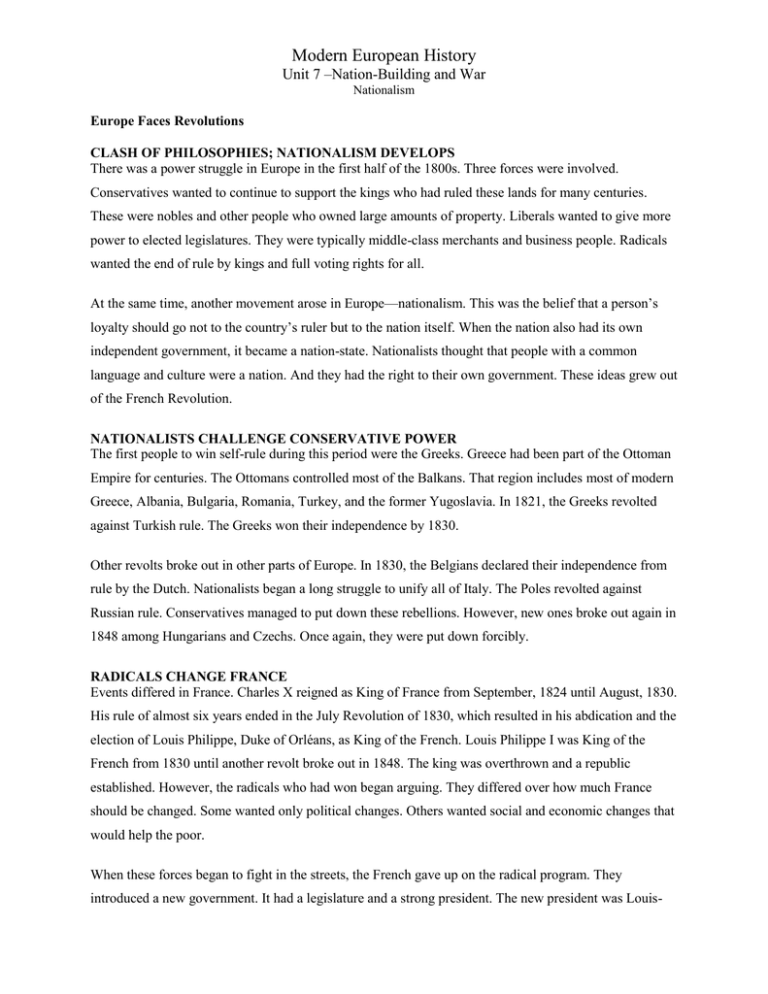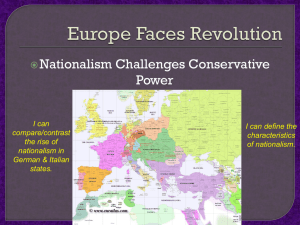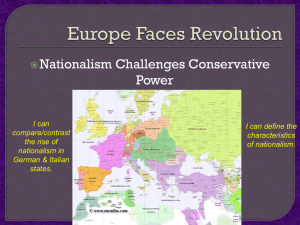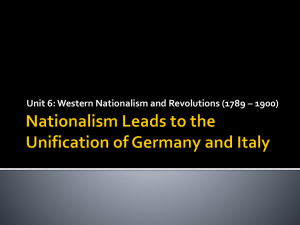Modern European History Unit 7 –Nation-Building and War
advertisement

Modern European History Unit 7 –Nation-Building and War Nationalism Europe Faces Revolutions CLASH OF PHILOSOPHIES; NATIONALISM DEVELOPS There was a power struggle in Europe in the first half of the 1800s. Three forces were involved. Conservatives wanted to continue to support the kings who had ruled these lands for many centuries. These were nobles and other people who owned large amounts of property. Liberals wanted to give more power to elected legislatures. They were typically middle-class merchants and business people. Radicals wanted the end of rule by kings and full voting rights for all. At the same time, another movement arose in Europe—nationalism. This was the belief that a person’s loyalty should go not to the country’s ruler but to the nation itself. When the nation also had its own independent government, it became a nation-state. Nationalists thought that people with a common language and culture were a nation. And they had the right to their own government. These ideas grew out of the French Revolution. NATIONALISTS CHALLENGE CONSERVATIVE POWER The first people to win self-rule during this period were the Greeks. Greece had been part of the Ottoman Empire for centuries. The Ottomans controlled most of the Balkans. That region includes most of modern Greece, Albania, Bulgaria, Romania, Turkey, and the former Yugoslavia. In 1821, the Greeks revolted against Turkish rule. The Greeks won their independence by 1830. Other revolts broke out in other parts of Europe. In 1830, the Belgians declared their independence from rule by the Dutch. Nationalists began a long struggle to unify all of Italy. The Poles revolted against Russian rule. Conservatives managed to put down these rebellions. However, new ones broke out again in 1848 among Hungarians and Czechs. Once again, they were put down forcibly. RADICALS CHANGE FRANCE Events differed in France. Charles X reigned as King of France from September, 1824 until August, 1830. His rule of almost six years ended in the July Revolution of 1830, which resulted in his abdication and the election of Louis Philippe, Duke of Orléans, as King of the French. Louis Philippe I was King of the French from 1830 until another revolt broke out in 1848. The king was overthrown and a republic established. However, the radicals who had won began arguing. They differed over how much France should be changed. Some wanted only political changes. Others wanted social and economic changes that would help the poor. When these forces began to fight in the streets, the French gave up on the radical program. They introduced a new government. It had a legislature and a strong president. The new president was Louis- Napoleon, Napoleon Bonaparte’s nephew. He later named himself emperor of France. He built railroads and helped industry. The economy got better and more people had jobs. REFORM IN RUSSIA In the early 1800s, Russia still did not have an industrial economy. The biggest problem was that serfdom still existed there. Peasants were bound to the nobles whose land they worked. Russia’s rulers were reluctant to free the serfs, though. They feared they would lose the support of the nobles. A new ruler of Russia, Alexander II, decided to free the serfs. Though it seemed bold, Alexander’s move went only part way. Nobles kept half their land and were paid for the other half that went to the peasants. The former serfs were not given the land. They had to pay for it. This debt kept them still tied to the land. The czar’s efforts to make changes ended when he was assassinated in 1881. Alexander III, the new czar, brought back tight control over the country. He also moved to make the economy more industrial. Find and highlight each of the following terms in the text along with their definition: conservatives liberals radical nationalism nation-state the Balkans Louis-Napoleon 1. What different goals did conservatives, liberals, and radicals have? _____________________________________________________________________________________ _____________________________________________________________________________________ _____________________________________________________________________________________ _____________________________________________________________________________________ _____________________________________________________________________________________ _____________________________________________________________________________________ _____________________________________________________________________________________ 2. What groups challenged conservative rule? _____________________________________________________________________________________ _____________________________________________________________________________________ _____________________________________________________________________________________ _____________________________________________________________________________________ _____________________________________________________________________________________ _____________________________________________________________________________________ _____________________________________________________________________________________ 2 3. What did Louis-Napoleon accomplish for France? _____________________________________________________________________________________ _____________________________________________________________________________________ _____________________________________________________________________________________ _____________________________________________________________________________________ _____________________________________________________________________________________ _____________________________________________________________________________________ _____________________________________________________________________________________ 4. What major reform was made in Russia at this time? _____________________________________________________________________________________ _____________________________________________________________________________________ _____________________________________________________________________________________ _____________________________________________________________________________________ _____________________________________________________________________________________ _____________________________________________________________________________________ _____________________________________________________________________________________ Nationalism Case Study: Italy and Germany NATIONALISM: A FORCE FOR UNITY OR DISUNITY Nationalists thought that many factors linked people to one another. First was nationality, or a common ethnic ancestry. Shared language, culture, history, and religion were also seen as ties that connected people. People sharing these traits were thought to have the right to a land they could call their own. Groups with their own government were called nation-states. Leaders began to see that this feeling could be a powerful force for uniting a people. The French Revolution was a prime example of this. However, nationalism could also be a force to rip apart empires. This happened in three empires in Europe. NATIONALISM SHAKES AGING EMPIRES Feelings of nationalism threatened to break apart three aging empires. The Austrian Empire was forced to split in two. One part was Austria, the other was Hungary. In Russia, harsh rule and a policy called Russification that forced other peoples to adopt Russian ways helped produce a revolution in 1917. This revolution overthrew the czar. Like the other two, the Ottoman Empire broke apart around the time of World War I. 3 CAVOUR UNITES ITALY Italians used national feeling to build a nation, not destroy an empire. Large parts of Italy were ruled by the kings of Austria and Spain. Nationalists tried to unite the nation in 1848. But the revolt was beaten down. Hopes rested with the Italian king of the state of Piedmont-Sardinia. His chief minister was Count Camillo di Cavour. Cavour worked to expand the king’s control over other areas of the north. Meanwhile, Giuseppe Garibaldi led an army of patriots that won control of southern areas. Garibaldi put the areas he conquered under control of the Italian king. In 1866, the area around Venice was added to the king’s control. By 1870, the king completed the uniting of Italy. BISMARCK UNITES GERMANY; A SHIFT IN POWER Germany had also been divided into many different states for many centuries. Since 1815, 39 states had joined in a league called the German Confederation. Prussia and Austria-Hungary controlled this group. Over time, Prussia rose to become more powerful. Leading this move was prime minister Otto von Bismarck. He was supported by wealthy landowners called Junkers. Bismarck was a master of realpolitik—tough power politics. Bismarck worked to create a new confederation of German states. Prussia controlled it. To win the loyalty of German areas in the south, he purposefully angered a weak France so that it would declare war on Prussia. Prussia won the Franco-Prussian War in 1871. The war with France gave the southern German states a nationalistic feeling. They joined the other states in naming the king of Prussia as emperor, or kaiser, of a strong united Germany. These events changed the balance of power in Europe. Germany and Britain were the strongest powers, followed by France. Austria, Russia, and Italy were all even weaker. Find and highlight each of the following terms in the text along with their definition: Russification Camillo di Cavour Giuseppe Garibaldi Otto von Bismarck realpolitik kaiser 1. What shared characteristics can unite people and create a strong national feeling? _____________________________________________________________________________________ _____________________________________________________________________________________ _____________________________________________________________________________________ _____________________________________________________________________________________ _____________________________________________________________________________________ _____________________________________________________________________________________ _____________________________________________________________________________________ 4 2. What three empires were torn apart by nationalism? Why did this happen? _____________________________________________________________________________________ _____________________________________________________________________________________ _____________________________________________________________________________________ _____________________________________________________________________________________ _____________________________________________________________________________________ _____________________________________________________________________________________ _____________________________________________________________________________________ 3. Who helped unify Italy and what did they do to help the unification? _____________________________________________________________________________________ _____________________________________________________________________________________ _____________________________________________________________________________________ _____________________________________________________________________________________ _____________________________________________________________________________________ _____________________________________________________________________________________ _____________________________________________________________________________________ 4. How did the policy of realpolitik lead to German unification? _____________________________________________________________________________________ _____________________________________________________________________________________ _____________________________________________________________________________________ _____________________________________________________________________________________ _____________________________________________________________________________________ _____________________________________________________________________________________ _____________________________________________________________________________________ 5. How did the Franco-Prussian War lead to German unification? _____________________________________________________________________________________ _____________________________________________________________________________________ _____________________________________________________________________________________ _____________________________________________________________________________________ _____________________________________________________________________________________ _____________________________________________________________________________________ _____________________________________________________________________________________ 5 The Unification of Italy, 1858 – 1870 1. What territories were annexed by Sardinia in 1860? __________________________ _____________________________________________________________________________________ 2. What Austrian territory was annexed by Sardinia in 1859? __________________________ 3. Which country annexed Rome in 1870? __________________________ 6 The Unification of Germany, 1865 – 1871 1. What were the three states annexed by Prussia, in 1866? ________________________________ 2. What are the three states that joined Prussia to form the Northern German Confederation, 1867? _____________________________________________________________________________________ 10. What four states joined the German Empire, 1871? ________________________________ _____________________________________________________________________________________ 7





